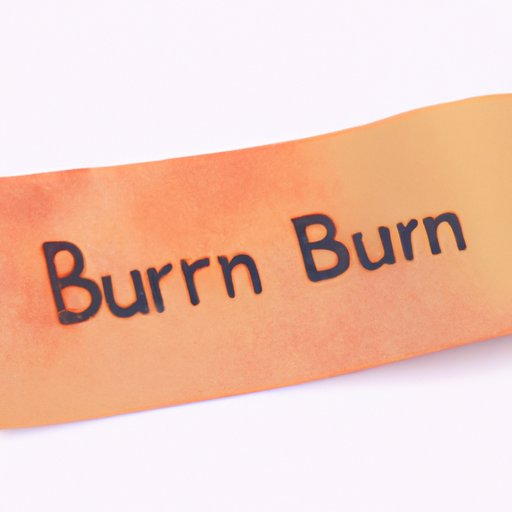
Introduction
Burns are a common injury that can occur at any time. While first-degree burns can usually be treated at home, second-degree burns require more attention. These burns are characterized by painful blisters, redness, and swelling, and can occur from exposure to fire, hot liquids, or electrical objects, among others. This article aims to provide readers with the necessary information to treat and prevent 2nd degree burns effectively.
First-Aid Measures
The key to treating second-degree burns is to begin first-aid measures immediately. Here’s what you need to do.
Cooling the Affected Area with Cold Water
The first step is to stop the burning process by cooling the affected area with cold water. Run the affected area under cool water for at least 10-15 minutes.
Removing Any Tight Clothing or Jewelry
It’s essential to remove any tight clothing, jewelry, or other items around the burned area. If the item is stuck, do not remove it. Instead, seek medical help.
Covering the Burn with a Clean, Dry Cloth
Cover the burn with a clean, dry cloth. This step will protect the area from germs and prevent further damage.
Importance of Not Applying Ice, Butter, or Other Home Remedies to the Burn
Ice, butter, and other home remedies do more harm than good. They can damage the skin and increase the risk of infection, thus should be avoided at all costs.
Home Remedies
Home remedies can help soothe the pain and promote healing.
Aloe Vera Gel
Aloe vera is a popular natural remedy known for its anti-inflammatory properties. Apply aloe vera gel directly to the affected area to soothe the pain and reduce redness.
Honey
Honey is an essential natural wound healer. It has anti-bacterial properties that work to keep the wound clean while preventing infections. Apply a thin layer of honey to the wound, and cover it with gauze.
Coconut Oil
Coconut oil has natural moisturizing properties that help soothe the injured skin. Simply apply a small amount of the oil to the area affected by the burn.
Instructions for Applying these Remedies to the Affected Area
To apply these remedies to the affected area, take the following steps:
– Wash your hands with soap and water before handling the burn
– Clean the area with cold water and pat dry
– Apply the desired natural remedy
– Cover the area with a sterile gauze or non-stick bandage
Medication
In some cases, medications may be prescribed to help manage the pain and prevent infection.
Painkillers
Painkillers such as ibuprofen can help reduce the pain and swelling associated with second-degree burns.
Antibiotics
If the burn becomes infected, antibiotics may be prescribed to clear the infection.
Topical Creams
Topical creams such as silver sulfadiazine or mafenide can help prevent infection and promote healing.
Professional Treatment
If the burn is severe, it may require professional medical treatment.
Debridement
Debridement involves removing dead skin or tissue from the affected area. This process helps prevent infections and promotes faster healing.
Skin Grafting
Skin grafting is a surgical procedure that involves transplanting healthy skin from another part of the body to the burned area.
Hyperbaric Oxygen Therapy
Hyperbaric oxygen therapy involves breathing pure oxygen in a pressurized room or tube. This therapy helps increase oxygen flow to the burned area, which promotes healing.
Prevention
The best way to treat a second-degree burn is to prevent it from happening in the first place.
Practicing Safe Cooking Techniques
Always keep a close eye on food cooking on the stove or in the oven. Use a timer to ensure food is not left for too long or forgotten.
Using Protective Clothing
Wear gloves, aprons, and other protective clothing when working with hot objects or liquids. Use oven mitts to avoid burns when handling hot pots and pans.
Being Cautious Around Hot Liquids and Surfaces
Always use caution when handling hot liquids or working near surfaces like grills or stovetops. Keep children and pets away from hot objects and surfaces.
Follow-Up Care
Follow-up care is critical to ensure that the wound heals correctly.
Keeping the Wound Clean and Dry
Wash the wound gently with soap and water daily. Pat dry and apply fresh dressing.
Changing Dressings Regularly
Change dressings regularly, as instructed by a healthcare professional.
Monitoring for Signs of Infection
Monitor the burn for signs of infection, such as increased pain, redness, swelling, or pus.
Recovery Time
The recovery period for second-degree burns typically takes two to three weeks. During this period, the skin will heal, and scabs may form. Do not pick at the scabs.
Conclusion
Treating and preventing second-degree burns requires quick action and proper care. While home remedies and medications can provide relief, severe burns may require professional medical treatment. To prevent burns, practice safe cooking techniques, use protective clothing, and observe caution when handling hot liquids or surfaces. Remember to follow-up care instructions and seek medical attention if needed. With proper care and attention, second-degree burns can heal and will not pose a risk to your general health.




